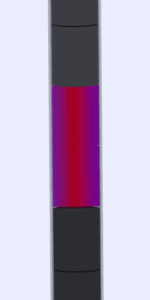Enthalpy of Nuclear Fuel – Acceptance Criteria

As was written, the enthalpy is one of thermodynamic potentials and represents a measure of energy in a thermodynamic system.
Enthalpy is an extensive quantity, it depends on the size of the system, or on the amount of substance it contains.
H = U + pV
Enthalpy of nuclear fuel is also used as an acceptance criterion in very specific types of accidents, known as reactivity initiated accidents (RIA), such as Rod Ejection Accidents. RIAs consist of postulated accidents which involve a sudden and rapid insertion of positive reactivity. As a result of rapid power excursion, fuel temperatures rapidly increase, prompting fuel pellet thermal expansion. The power excursion is initially mitigated by the fuel temperature coefficient (or Doppler feedback), which will be the first feedback, that will compensate the inserted positive reactivity.
In these accidents, the large and rapid deposition of energy in the fuel can result in melting, fragmentation, and dispersal of fuel. The mechanical action associated with fuel dispersal can be sufficient to destroy the cladding and the rod-bundle geometry of the fuel and produce pressure pulses in the primary system. The expulsion of hot fuel into water has potential to cause rapid steam generation and these pressure pulses, which could damage nearby fuel assemblies. Limits on specific fuel enthalpy are used, because the experimental tests show that degree of fuel rod damage correlates well with the peak value of fuel pellet specific enthalpy.
Regulatory acceptance criteria vary with country and reactor type, but there are usually two kinds of fuel enthalpy limits:
- CORE COOLABILITY CRITERIA. Reduction of coolability can result from violent expulsion of fuel, which could damage nearby fuel assemblies. In past, the core coolability criteria was revised to specifically address both short-term (e.g., fuel-to-coolant interaction, rod burst) and long-term (e.g., fuel rod ballooning, flow blockage) phenomena which challenge coolable geometry and reactor pressure boundary integrity. A definite limit for core damage, which must not be exceeded at any position in any fuel rod in the core. According to Appendix B of the Standard Review Plan, Section 4.2, these criteria are, for example:
- Peak radial average fuel enthalpy must remain below 230 cal/g. Above this enthalpy, hot fuel particles might be expelled from a fuel rod.
- Peak fuel temperature must remain below incipient fuel melting conditions.
- FUEL CLADDING FAILURE CRITERIA. A fuel rod failure threshold, that define whether a fuel rod should be considered as failed or not in calculations of radioactive release (source term). According to Appendix B of the Standard Review Plan, Section 4.2 fuel rods may fail by several damage mechanisms:
- The high cladding temperature failure criteria for zero power conditions is a peak radial average fuel enthalpy greater than 170 cal/g for fuel rods with an internal rod pressure at or below system pressure and 150 cal/g for fuel rods with an internal rod pressure exceeding system pressure.
- The PCMI failure criteria is a change in radial average fuel enthalpy greater than the corrosion-dependent limit depicted in Appendix B of the Standard Review Plan, Section 4.2.
As can be seen, the fuel specific enthalpy, i.e. the enthalpy per unit mass of the fuel pellet material, is therefore a fundamental parameter in discussions of reactivity initiated accidents. Fuel cladding failure may occur almost instantaneously during the prompt fuel enthalpy rise (due to PCMI) or may occur as total fuel enthalpy (prompt + delayed), heat flux, and cladding temperature increase. For the purpose of calculating fuel enthalpy for assessing PCMI failures, the prompt fuel enthalpy rise is defined as the radial average fuel enthalpy rise at the time corresponding to one pulse width after the peak of the prompt pulse. For assessing high cladding temperature failures, the total radial average fuel enthalpy (prompt + delayed) should be used.
Special Reference: US NRC. Standard Review Plan – NUREG-0800. 4.2 FUEL SYSTEM DESIGN. Revision 3 – March 2007.
Special Reference: OECD Nuclear Energy Agency State-of-the-art Report, “Nuclear Fuel Behaviour under RIA Conditions”, 2010.
Special Reference: Peter Rudling, Lars Olof Jernkvist. Nuclear Fuel Behaviour under RIA Conditions. Advanced Nuclear Technology International, 12/2016.
We hope, this article, Enthalpy – Nuclear Fuel, helps you. If so, give us a like in the sidebar. Main purpose of this website is to help the public to learn some interesting and important information about thermal engineering.